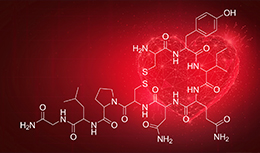Drop Date: November 2021
Piloting Salivary Oxytocin – Observations and Opportunities for Research
In This Drop: Piloting Salivary Oxytocin – Observations and Opportunities for Research
The Salimetrics’ ground-breaking salivary oxytocin assay was designed specifically for saliva with Salimetrics’ unique knowledge and experience. Early results are in – not only does the assay range span the levels appropriate in saliva, but researchers can also differentiate small, meaningful changes in salivary oxytocin levels that were not detectable before.

Researchers now have the ability to measure early indicators with a sensitivity so low that minute changes in oxytocin biology can be seen. Since the launch of the new Salimetrics assay, more than 300 researchers have requested information on how to incorporate salivary oxytocin into their grants, and early adopters are now publishing their research. While oxytocin levels have been previously measured in blood, breast milk, urine, and CSF, each of these fluids have limitations when appreciating a differential induction of oxytocin. Saliva has the distinct advantages of being both non-invasive and readily accessible, allowing for in-depth monitoring of peripheral oxytocin levels under basal and stimulated conditions. This makes saliva the right choice for oxytocin research.
Previously, the science behind oxytocin testing was limited by the differing methods used to measure it. While debate still exists regarding the forms of oxytocin detected by each method, research using plasma and serum established that oxytocin exists both as a cyclic molecule and complexed with other disulfide containing proteins (Brandtzaeg et al., 2016; Martin, 2016). This natural tendency of oxytocin to covalently adhere to proteins through disulfide exchange results in free and bound oxytocin pools. Therefore, levels measured by methods that only detect the free form may underestimate the total amount of oxytocin present. Based on this concept, some researchers believe pre-processing of the saliva sample is required. However, pre-processing, such as using Solid Phase Extraction (SPE), was shown to significantly reduce measurable oxytocin levels, and recent LC-MS evidence supports the conclusion that samples with low levels of oxytocin were simply due to the inability to detect oxytocin molecules when bound to plasma proteins (Brandtzaeg et al., 2016; Martin and Carter, 2013; Szeto, et al., 2011; Martin, 2016). In practice, most researchers publishing in the literature today choose to concentrate saliva samples, emphasizing the need for well-validated controls and methods in order to avoid the risk of discarding oxytocin and misrepresenting detectable levels.
With salivary oxytocin, investigators can achieve biological evidence to define attachment, pair-bonding, and social behavior in more detail with high ecological value. Using well-validated controls and methods, the Salimetrics’ salivary oxytocin assay detects oxytocin in whole, non-extracted saliva using low test volumes, and does not require additional sample manipulation. Salimetrics has rigorously validated this assay based on well-defined product development procedures and assay validation criteria that exceeds the industry standard for assay validation. Further, applied depletion studies have provided an extra level of robustness to give researchers the highest level of confidence in their results. The table below, featuring key improvements with Salimetrics, illustrates the average results of specific methods from Salimetrics’ validation criteria (full validation report available on request).
Oxytocin Validation Summary
| Assessment | Results |
| Functional (LLOQ) | 8 pg/mL |
| Analytical (LLOD) | 4 pg/mL |
| Intra-Assay Precision | CV= 16.03% (N=45) |
| Inter-Assay Precision | CV= 3.9% (N=45) |
| Spike and Recovery | 16.3 pg/mL Recovery=109% (N=15) |
| Sample Type | Whole Saliva (no extraction/concentration) |
| Approved Collection Method(s) | Passive Drool |
Understanding the different methods available to researchers and subsequently choosing a method that meets rigorous validation criteria will enable researchers to pioneer an increased understanding of oxytocin regulated biological processes. Based on this solid foundation of rigor and reproducibility, the increased analytical sophistication, and robust validation of this assay opens a wide window for piloting different sample sets and stimuli for the salivary bioscience community.
REFERENCES & RELATED RESEARCH
- Brandtzaeg, O.K., Johnsen, E., Roberg-Larsen, H., Seip, K.F., MacLean, E.L., Gesquiere, L.R., Leknes, S., Lundanes, E., and Wilson, S.R. (2016). Proteomics tools reveal startlingly high amounts of oxytocin in plasma and serum. Sci Rep 6, 31693.
- Martin, W.L. (2016). Measurement of Oxytocin and Vasopressin (US20160377635A1)
- Martin, W. L., and Carter, C. S. (2013). Oxytocin and vasopressin are sequestered in plasma. Presented at the 10th World Congress on Neurohypophysial Hormones. Bristol, England.
- Carter, C.S., Pournajafi-Nazarloo, H., Kramer, K.M., Ziegler, T.E., White-Traut, R., Bello, D., and Schwertz, D. (2007). Oxytocin: behavioral associations and potential as a salivary biomarker. Annals of the New York Academy of Sciences 1098, 312-322.
- Szeto A, McCabe PM, Nation DA, Tabak BA, Rossetti MA, McCullough ME, Schneiderman N, Mendez AJ. ( 2011). Evaluation of enzyme immunoassay and radioimmunoassay methods for the measurement of plasma oxytocin. Psychosom Med 73(5):393-400.
*Note: Salimetrics provides this information for research use only (RUO). Information is not provided to promote off-label use of medical devices. Please consult the full-text article.
 Contact: Salimetrics (USA)
Contact: Salimetrics (USA)